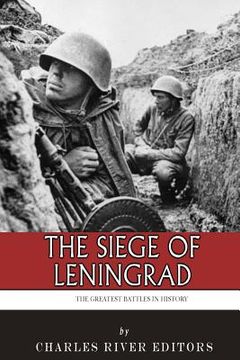Reseña del libro "The Greatest Battles in History: The Siege of Leningrad (en Inglés)"
*Includes pictures. *Includes accounts of the siege by citizens, soldiers and important generals. *Includes a bibliography for further reading. "The city is dead. There is no electricity, no trams. Warm rooms are rare. No water. Almost the only form of transport is sleds, carrying corpses in plain coffins, covered with rags or half clothed. Daily six to eight thousand die. The city is dying as it has lived for the last half year - clenching its teeth." - Nikolai Markevich's diary entry on January 24, 1942. The casualties inflicted on all sides during World War II nearly defy belief, and even today estimates of the number of dead differ by tens of millions of people. Amid all of the destruction and carnage, perhaps nothing symbolizes the war quite like the Siege of Leningrad, one of the longest sieges in history and by far the deadliest. When the Soviet-Nazi non-aggression pact of 1939 was broken by a German offensive against Russia, the surprised Red Army was quickly driven eastward away from the border with Poland, and Russian forces found themselves in a desperate attempt to defend major Russian cities from the Germany invaders. Leningrad, which had a population of roughly three million on the eve of the German attack, was one of the victims of the Russian unpreparedness, but once the siege began in the fall of 1941, the Soviets knew they were in a desperate struggle to the death. In fact, the Russians wouldn't have even been given a chance to surrender if they had wanted to, because the orders to the German forces instructed them to completely raze the city: "After the defeat of Soviet Russia there can be no interest in the continued existence of this large urban center...Following the city's encirclement, requests for surrender negotiations shall be denied, since the problem of relocating and feeding the population cannot and should not be solved by us. In this war for our very existence, we can have no interest in maintaining even a part of this very large urban population." The Russians managed to barely supply the encircled city through a small corridor of land that connected to Lake Ladoga, with transports crossing the lake when it froze over in winter. This euphemistically became known as the Road of Life, but the precarious conditions and the Luftwaffe also left many referring to it as the Road of Death. And even though the Nazis never managed to entirely cut off that supply route, during the nearly 900 day siege, which lasted from September 1941 - January 1944, at least 750,000 civilians starved to death, one out of every three or four members of the pre-siege population. The siege was so devastating that estimates of civilian dead from all causes were estimated at over a million. To put the massive death toll of the siege of Leningrad in perspective, roughly 35 times more civilians died at Leningrad than in the London Blitz, and 4 times more died than in the bombings of Nagasaki and Hiroshima combined. Of course, the civilians were hardly the only ones struggling around Leningrad during the siege, because soldiers on both sides had to deal with combat and terrible weather conditions over the course of nearly 28 months. By the time the siege was lifted, the Germans had suffered an estimated 1 million casualties, while the Soviets suffered an estimated 1 million dead or missing and over 2 million wounded. Not surprisingly, the city itself was a hollow shell of itself, with over 11,000 buildings destroyed and wreckage strewn everywhere. The Greatest Battles in History: The Siege of Leningrad comprehensively covers the entire military situation that led up to the siege, analyzes the decisions made by important leaders, and explains the aftermath of the Soviet victory. Along with a bibliography and pictures of important people and places, you will learn about the Siege of Leningrad like never before, in no time at all.

